LIBROS
Verónica Córdoba
 Verónica Córdova's doctoral dissertation entitled Cinema and Revolution in Latin America: A Cinematic Reading of History. A Historical Reading of Film, presents new opportunities for evaluating the historical trajectory and importance of a significant cinematic movement, the New Latin American Cinema movement. Córdova makes an important contribution as a Latin American filmmaker and scholar within a field that is dominated by either American or European scholars. This provides her with a unique opportunity to reflect, beyond her native Bolivia, not only on the historical trajectory of a cinema movement that gave context to her own training as a filmmaker, but also on the way in which the field has been constructed by various scholarly positions.
Verónica Córdova's doctoral dissertation entitled Cinema and Revolution in Latin America: A Cinematic Reading of History. A Historical Reading of Film, presents new opportunities for evaluating the historical trajectory and importance of a significant cinematic movement, the New Latin American Cinema movement. Córdova makes an important contribution as a Latin American filmmaker and scholar within a field that is dominated by either American or European scholars. This provides her with a unique opportunity to reflect, beyond her native Bolivia, not only on the historical trajectory of a cinema movement that gave context to her own training as a filmmaker, but also on the way in which the field has been constructed by various scholarly positions.
 Verónica Córdova's doctoral dissertation entitled Cinema and Revolution in Latin America: A Cinematic Reading of History. A Historical Reading of Film, presents new opportunities for evaluating the historical trajectory and importance of a significant cinematic movement, the New Latin American Cinema movement. Córdova makes an important contribution as a Latin American filmmaker and scholar within a field that is dominated by either American or European scholars. This provides her with a unique opportunity to reflect, beyond her native Bolivia, not only on the historical trajectory of a cinema movement that gave context to her own training as a filmmaker, but also on the way in which the field has been constructed by various scholarly positions.
Verónica Córdova's doctoral dissertation entitled Cinema and Revolution in Latin America: A Cinematic Reading of History. A Historical Reading of Film, presents new opportunities for evaluating the historical trajectory and importance of a significant cinematic movement, the New Latin American Cinema movement. Córdova makes an important contribution as a Latin American filmmaker and scholar within a field that is dominated by either American or European scholars. This provides her with a unique opportunity to reflect, beyond her native Bolivia, not only on the historical trajectory of a cinema movement that gave context to her own training as a filmmaker, but also on the way in which the field has been constructed by various scholarly positions.Fernando Birri
 Este libro recopila escritos teóricos y poéticos de Fernando Birri dispersos a lo largo y lo ancho del mundo audiovisual en 35 años de Nuevo Cine Latinoamericano. Textos coyunturales en su mayor parte nacidos en estado de necesidad, cuando no de gracia, pero que releídos desde hoy anticipan una coherente, original y subversiva propuesta tercermundista ideológica y estética.
Este libro recopila escritos teóricos y poéticos de Fernando Birri dispersos a lo largo y lo ancho del mundo audiovisual en 35 años de Nuevo Cine Latinoamericano. Textos coyunturales en su mayor parte nacidos en estado de necesidad, cuando no de gracia, pero que releídos desde hoy anticipan una coherente, original y subversiva propuesta tercermundista ideológica y estética.
 Este libro recopila escritos teóricos y poéticos de Fernando Birri dispersos a lo largo y lo ancho del mundo audiovisual en 35 años de Nuevo Cine Latinoamericano. Textos coyunturales en su mayor parte nacidos en estado de necesidad, cuando no de gracia, pero que releídos desde hoy anticipan una coherente, original y subversiva propuesta tercermundista ideológica y estética.
Este libro recopila escritos teóricos y poéticos de Fernando Birri dispersos a lo largo y lo ancho del mundo audiovisual en 35 años de Nuevo Cine Latinoamericano. Textos coyunturales en su mayor parte nacidos en estado de necesidad, cuando no de gracia, pero que releídos desde hoy anticipan una coherente, original y subversiva propuesta tercermundista ideológica y estética. Mariano Oliveros
 El texto constituye un material de consulta sobre el largo proceso de la producción cinematográfico actual, fundamental para la persona que esté interesada en realizar cine de manera independiente o dentro de la industria. Cuenta con la opinión de programadores de festivales, guionistas, abogados que se dedican exclusivamente a temas vinculados al cine y otros especialistas que aconsejan cómo realizar una película.
El texto constituye un material de consulta sobre el largo proceso de la producción cinematográfico actual, fundamental para la persona que esté interesada en realizar cine de manera independiente o dentro de la industria. Cuenta con la opinión de programadores de festivales, guionistas, abogados que se dedican exclusivamente a temas vinculados al cine y otros especialistas que aconsejan cómo realizar una película.
 El texto constituye un material de consulta sobre el largo proceso de la producción cinematográfico actual, fundamental para la persona que esté interesada en realizar cine de manera independiente o dentro de la industria. Cuenta con la opinión de programadores de festivales, guionistas, abogados que se dedican exclusivamente a temas vinculados al cine y otros especialistas que aconsejan cómo realizar una película.
El texto constituye un material de consulta sobre el largo proceso de la producción cinematográfico actual, fundamental para la persona que esté interesada en realizar cine de manera independiente o dentro de la industria. Cuenta con la opinión de programadores de festivales, guionistas, abogados que se dedican exclusivamente a temas vinculados al cine y otros especialistas que aconsejan cómo realizar una película. Gerardo Vallejo, Eva Marta Piwowarski
 Biografía del realizador, productor, camarógrafo y guionista argentino Gerardo Vallejo
Biografía del realizador, productor, camarógrafo y guionista argentino Gerardo Vallejo
 Biografía del realizador, productor, camarógrafo y guionista argentino Gerardo Vallejo
Biografía del realizador, productor, camarógrafo y guionista argentino Gerardo VallejoInstituto Moreira Salles (IMS), Geraldo Sarno


Filmoteca Española
 Dossier sobre la obra del realizador alemán Hans-Jürgen Syberberg
Dossier sobre la obra del realizador alemán Hans-Jürgen Syberberg
 Dossier sobre la obra del realizador alemán Hans-Jürgen Syberberg
Dossier sobre la obra del realizador alemán Hans-Jürgen Syberberg  El Festival Internacional de Cine de Cartagena de Indias - FICCI - es un espacio cultural cinematográfico de carácter internacional que se lleva a cabo desde el año 1960 en Cartagena de Indias, Colombia, siendo el evento cinematográfico más antiguo de Latinoamérica.
El Festival Internacional de Cine de Cartagena de Indias - FICCI - es un espacio cultural cinematográfico de carácter internacional que se lleva a cabo desde el año 1960 en Cartagena de Indias, Colombia, siendo el evento cinematográfico más antiguo de Latinoamérica.
Protagonista enfrentado a la dictadura militar impuesta en Brasil a partir de 1964, y como muestra de rechazo a ese estado de fuerza, Glauber Rocha opta por el exilio. Después de peregrinar por varios países, arriba a Cuba en 1971, precedido por los éxitos de sus primeras películas y la aureola de ser la figura central del movimiento del Cinema Novo en América Latina. En la Isla permanecerá hasta 1972, y en ella encontrará el amor, entre otras obseciones.
Juan Antonio García Borrero
 Este libro nos introduce en el mundo del llamado Cine cubano sumergido que no es ni mas ni menos que aquel cine que se encuentra fuera de los circuitos de distribución y exhibición convencionales, se ven relegados a ese otro mundo donde sólo se puede tener acceso a visionarlo bien en algún festival, semana o manifestación cultural. Se trata de un cine social, rabiosamente crítico pero no antigubernamental sino más bien en mucho de los casos anti-cine convencional u oficial. Acompaña a este ensayo, una muy amplia relación de títulos que podrían componer toda una historia del corto cubano sumergido y terminando con otra también amplia selección de películas que son citadas en el libro con sus fichas técnicas, sinopsis y breves semblanzas de sus directores.
Este libro nos introduce en el mundo del llamado Cine cubano sumergido que no es ni mas ni menos que aquel cine que se encuentra fuera de los circuitos de distribución y exhibición convencionales, se ven relegados a ese otro mundo donde sólo se puede tener acceso a visionarlo bien en algún festival, semana o manifestación cultural. Se trata de un cine social, rabiosamente crítico pero no antigubernamental sino más bien en mucho de los casos anti-cine convencional u oficial. Acompaña a este ensayo, una muy amplia relación de títulos que podrían componer toda una historia del corto cubano sumergido y terminando con otra también amplia selección de películas que son citadas en el libro con sus fichas técnicas, sinopsis y breves semblanzas de sus directores.
 Este libro nos introduce en el mundo del llamado Cine cubano sumergido que no es ni mas ni menos que aquel cine que se encuentra fuera de los circuitos de distribución y exhibición convencionales, se ven relegados a ese otro mundo donde sólo se puede tener acceso a visionarlo bien en algún festival, semana o manifestación cultural. Se trata de un cine social, rabiosamente crítico pero no antigubernamental sino más bien en mucho de los casos anti-cine convencional u oficial. Acompaña a este ensayo, una muy amplia relación de títulos que podrían componer toda una historia del corto cubano sumergido y terminando con otra también amplia selección de películas que son citadas en el libro con sus fichas técnicas, sinopsis y breves semblanzas de sus directores.
Este libro nos introduce en el mundo del llamado Cine cubano sumergido que no es ni mas ni menos que aquel cine que se encuentra fuera de los circuitos de distribución y exhibición convencionales, se ven relegados a ese otro mundo donde sólo se puede tener acceso a visionarlo bien en algún festival, semana o manifestación cultural. Se trata de un cine social, rabiosamente crítico pero no antigubernamental sino más bien en mucho de los casos anti-cine convencional u oficial. Acompaña a este ensayo, una muy amplia relación de títulos que podrían componer toda una historia del corto cubano sumergido y terminando con otra también amplia selección de películas que son citadas en el libro con sus fichas técnicas, sinopsis y breves semblanzas de sus directores. El Simposio Internacional en línea sobre “Prevención y manejo de desastres naturales y humanos en archivos cinematográficos”, organizado por la Filmoteca de la Universidad Nacional Autónoma de México (UNAM) y la Federación Internacional de Archivos Fílmicos (FIAF), presenta a expertos de diversos archivos fílmicos de todo el mundo: Suiza, Argentina, Brasil, Francia, Tailandia, España, Croacia, Estados Unidos y México, quienes abordan el tema de los desastres naturales en América Latina, Asia y Europa; así como la gestión de riesgos y planeación a futuro.
El Simposio Internacional en línea sobre “Prevención y manejo de desastres naturales y humanos en archivos cinematográficos”, organizado por la Filmoteca de la Universidad Nacional Autónoma de México (UNAM) y la Federación Internacional de Archivos Fílmicos (FIAF), presenta a expertos de diversos archivos fílmicos de todo el mundo: Suiza, Argentina, Brasil, Francia, Tailandia, España, Croacia, Estados Unidos y México, quienes abordan el tema de los desastres naturales en América Latina, Asia y Europa; así como la gestión de riesgos y planeación a futuro.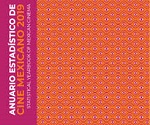 Hace diez años se presentó por primera vez el Anuario estadístico de cine mexicano, una herramienta primordial de consulta pública para el sector cinematográfico en nuestro país de utilidad para realizadores, productores, guionistas, exhibidores, distribuidores, investigadores, periodistas, economistas, promotores y gestores culturales, así como para el público en general interesado en la actividad cinematográfica nacional.
Hace diez años se presentó por primera vez el Anuario estadístico de cine mexicano, una herramienta primordial de consulta pública para el sector cinematográfico en nuestro país de utilidad para realizadores, productores, guionistas, exhibidores, distribuidores, investigadores, periodistas, economistas, promotores y gestores culturales, así como para el público en general interesado en la actividad cinematográfica nacional.Amanda Sánchez Vega
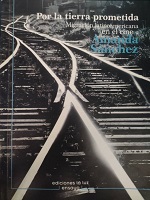 «El viaje que se nos presenta transita por las problemáticas referidas a la migración latinoamericana hacia los Estados Unidos en un grupo de largometrajes de ficción realizados entre 2011 y 2016. Durante este periodo se produce un boom de migrant films centrados en los latinos que se dirigen hacia el territorio del Norte. A la par, en ese momento Obama está sumido en una carrera por su relección de 2012 y en los intentos fallidos de introducir cambios en las políticas migratorias. Los filmes pertenecen a producciones de México, Estados Unidos y Cuba y, como se leerá, muestran las realidades de los migrantes tanto en los países de origen, como durante el tránsito y en el país de destino»
«El viaje que se nos presenta transita por las problemáticas referidas a la migración latinoamericana hacia los Estados Unidos en un grupo de largometrajes de ficción realizados entre 2011 y 2016. Durante este periodo se produce un boom de migrant films centrados en los latinos que se dirigen hacia el territorio del Norte. A la par, en ese momento Obama está sumido en una carrera por su relección de 2012 y en los intentos fallidos de introducir cambios en las políticas migratorias. Los filmes pertenecen a producciones de México, Estados Unidos y Cuba y, como se leerá, muestran las realidades de los migrantes tanto en los países de origen, como durante el tránsito y en el país de destino»
 «El viaje que se nos presenta transita por las problemáticas referidas a la migración latinoamericana hacia los Estados Unidos en un grupo de largometrajes de ficción realizados entre 2011 y 2016. Durante este periodo se produce un boom de migrant films centrados en los latinos que se dirigen hacia el territorio del Norte. A la par, en ese momento Obama está sumido en una carrera por su relección de 2012 y en los intentos fallidos de introducir cambios en las políticas migratorias. Los filmes pertenecen a producciones de México, Estados Unidos y Cuba y, como se leerá, muestran las realidades de los migrantes tanto en los países de origen, como durante el tránsito y en el país de destino»
«El viaje que se nos presenta transita por las problemáticas referidas a la migración latinoamericana hacia los Estados Unidos en un grupo de largometrajes de ficción realizados entre 2011 y 2016. Durante este periodo se produce un boom de migrant films centrados en los latinos que se dirigen hacia el territorio del Norte. A la par, en ese momento Obama está sumido en una carrera por su relección de 2012 y en los intentos fallidos de introducir cambios en las políticas migratorias. Los filmes pertenecen a producciones de México, Estados Unidos y Cuba y, como se leerá, muestran las realidades de los migrantes tanto en los países de origen, como durante el tránsito y en el país de destino» Jorge Ayala Blanco
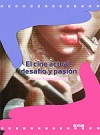

El brillante estilo verbal de Jorge Ayala Blanco se despliega en estas páginas para ofrecer un recuento crítico del cine internacional en los últimos años. En ellas hallamos reflexiones radicales, detonadoras -pero no por ello menos razonables o informativas- sobre cintas de los más variados registros y propósitos: películas comerciales, cine de autor y rarezas de latitudes exóticas para el espectador mexicano.
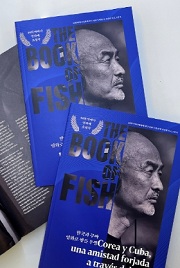 Libro programa de la proyección de películas coreanas y exhibición fotográfica durante el 44 Festival Internacional del Nuevo Cine Latinoamericano de La Habana. Presentación especial de la película coreana “The Book of Fish" (El libro del pez), del reconocido director surcoreano de cine Lee Joon-ik.
Libro programa de la proyección de películas coreanas y exhibición fotográfica durante el 44 Festival Internacional del Nuevo Cine Latinoamericano de La Habana. Presentación especial de la película coreana “The Book of Fish" (El libro del pez), del reconocido director surcoreano de cine Lee Joon-ik.Miguel Angel Márdero Arellano, Flor de Maria Silvestre Estela, Alice da Silva dos Santos
 Esta bibliografía representa un conglomerado de curaduría de información que ha sido recuperada y seleccionada por integrantes del grupo de investigación en preservación digital Dríade de Brasil, para complementar la actualización del trabajo realizado en habla hispana sobre el tema y contribuir en fortalecer una red de enfoque para dar accesibilidad y tropicalizar al español las directrices, iniciativas, normas y casos de programas de preservación digital de la última década para potenciar la episteme y la tekné en la materia.
Esta bibliografía representa un conglomerado de curaduría de información que ha sido recuperada y seleccionada por integrantes del grupo de investigación en preservación digital Dríade de Brasil, para complementar la actualización del trabajo realizado en habla hispana sobre el tema y contribuir en fortalecer una red de enfoque para dar accesibilidad y tropicalizar al español las directrices, iniciativas, normas y casos de programas de preservación digital de la última década para potenciar la episteme y la tekné en la materia.
 Esta bibliografía representa un conglomerado de curaduría de información que ha sido recuperada y seleccionada por integrantes del grupo de investigación en preservación digital Dríade de Brasil, para complementar la actualización del trabajo realizado en habla hispana sobre el tema y contribuir en fortalecer una red de enfoque para dar accesibilidad y tropicalizar al español las directrices, iniciativas, normas y casos de programas de preservación digital de la última década para potenciar la episteme y la tekné en la materia.
Esta bibliografía representa un conglomerado de curaduría de información que ha sido recuperada y seleccionada por integrantes del grupo de investigación en preservación digital Dríade de Brasil, para complementar la actualización del trabajo realizado en habla hispana sobre el tema y contribuir en fortalecer una red de enfoque para dar accesibilidad y tropicalizar al español las directrices, iniciativas, normas y casos de programas de preservación digital de la última década para potenciar la episteme y la tekné en la materia.Claudine de France
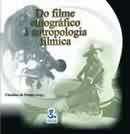 Los antropólogos-cineastas autores de esta obra, incluido Jean Rouch, discuten su nuevo instrumento de investigación y expresión, el cine etnográfico, y su uso como herramienta antropológica. Importante aporte para investigadores y estudiantes de antropología visual.
Los antropólogos-cineastas autores de esta obra, incluido Jean Rouch, discuten su nuevo instrumento de investigación y expresión, el cine etnográfico, y su uso como herramienta antropológica. Importante aporte para investigadores y estudiantes de antropología visual.
 Los antropólogos-cineastas autores de esta obra, incluido Jean Rouch, discuten su nuevo instrumento de investigación y expresión, el cine etnográfico, y su uso como herramienta antropológica. Importante aporte para investigadores y estudiantes de antropología visual.
Los antropólogos-cineastas autores de esta obra, incluido Jean Rouch, discuten su nuevo instrumento de investigación y expresión, el cine etnográfico, y su uso como herramienta antropológica. Importante aporte para investigadores y estudiantes de antropología visual.Claudine de France
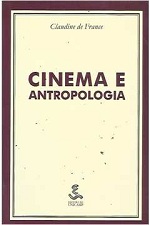 ¿Sería posible la existencia de una antropología basada en el uso de la cinematografía? ¿Cuáles serían las implicaciones teóricas y metodológicas que subyacen a este uso? Claudine de France expone en Cine y Antropología los fundamentos, principios y estrategias de lo que ella llama "antropología fílmica", es decir, una antropología que progresivamente se libera de las garras de la escritura y revela aspectos del comportamiento humano que los métodos tradicionales de observación y descripción Sólo daba la ilusión de saberlo. La introducción del cine en el aparato de investigación antropológica no sólo abre nuevos horizontes a la disciplina, sino que también pone en duda algunos postulados metodológicos de las ciencias observacionales.
¿Sería posible la existencia de una antropología basada en el uso de la cinematografía? ¿Cuáles serían las implicaciones teóricas y metodológicas que subyacen a este uso? Claudine de France expone en Cine y Antropología los fundamentos, principios y estrategias de lo que ella llama "antropología fílmica", es decir, una antropología que progresivamente se libera de las garras de la escritura y revela aspectos del comportamiento humano que los métodos tradicionales de observación y descripción Sólo daba la ilusión de saberlo. La introducción del cine en el aparato de investigación antropológica no sólo abre nuevos horizontes a la disciplina, sino que también pone en duda algunos postulados metodológicos de las ciencias observacionales.
 ¿Sería posible la existencia de una antropología basada en el uso de la cinematografía? ¿Cuáles serían las implicaciones teóricas y metodológicas que subyacen a este uso? Claudine de France expone en Cine y Antropología los fundamentos, principios y estrategias de lo que ella llama "antropología fílmica", es decir, una antropología que progresivamente se libera de las garras de la escritura y revela aspectos del comportamiento humano que los métodos tradicionales de observación y descripción Sólo daba la ilusión de saberlo. La introducción del cine en el aparato de investigación antropológica no sólo abre nuevos horizontes a la disciplina, sino que también pone en duda algunos postulados metodológicos de las ciencias observacionales.
¿Sería posible la existencia de una antropología basada en el uso de la cinematografía? ¿Cuáles serían las implicaciones teóricas y metodológicas que subyacen a este uso? Claudine de France expone en Cine y Antropología los fundamentos, principios y estrategias de lo que ella llama "antropología fílmica", es decir, una antropología que progresivamente se libera de las garras de la escritura y revela aspectos del comportamiento humano que los métodos tradicionales de observación y descripción Sólo daba la ilusión de saberlo. La introducción del cine en el aparato de investigación antropológica no sólo abre nuevos horizontes a la disciplina, sino que también pone en duda algunos postulados metodológicos de las ciencias observacionales. Marcius Freire, Philippe Lourdou
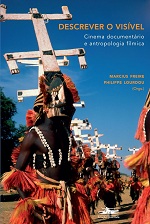 Describiendo lo visible, que compone un estudio sobre el uso del cine como instrumento de investigación antropológica y etnográfica, es el resultado de años de trabajo de antropólogos-cineastas, bajo la organización de Marcius Freire y Phillipe Lourdou, ambos participantes de la escuela de antropología de Nanterre. Documental creado por Jean Rouch. Reuniendo diez textos relevantes sobre la llamada antropología fílmica, la obra presenta, a través de reflexiones conceptuales y estudios de casos, perspectivas diversas -pero, a menudo, convergentes- sobre los procedimientos de puesta en escena del documentalista frente a los innumerables desafíos que este -tipo de acercamiento al objeto de estudio -desde las dificultades de inserción en algunas sociedades poco acostumbradas al cineasta 'intruso', pasando por la casi siempre inevitable pérdida de naturalidad que provoca la presencia de la cámara y llegar a la peligrosa fase del montaje. Qué mostrar, cómo mostrar y por qué mostrar son preguntas primordiales y cotidianas para el documental antropológico y guían las consideraciones presentes en los diez textos que componen el libro.
Describiendo lo visible, que compone un estudio sobre el uso del cine como instrumento de investigación antropológica y etnográfica, es el resultado de años de trabajo de antropólogos-cineastas, bajo la organización de Marcius Freire y Phillipe Lourdou, ambos participantes de la escuela de antropología de Nanterre. Documental creado por Jean Rouch. Reuniendo diez textos relevantes sobre la llamada antropología fílmica, la obra presenta, a través de reflexiones conceptuales y estudios de casos, perspectivas diversas -pero, a menudo, convergentes- sobre los procedimientos de puesta en escena del documentalista frente a los innumerables desafíos que este -tipo de acercamiento al objeto de estudio -desde las dificultades de inserción en algunas sociedades poco acostumbradas al cineasta 'intruso', pasando por la casi siempre inevitable pérdida de naturalidad que provoca la presencia de la cámara y llegar a la peligrosa fase del montaje. Qué mostrar, cómo mostrar y por qué mostrar son preguntas primordiales y cotidianas para el documental antropológico y guían las consideraciones presentes en los diez textos que componen el libro.
 Describiendo lo visible, que compone un estudio sobre el uso del cine como instrumento de investigación antropológica y etnográfica, es el resultado de años de trabajo de antropólogos-cineastas, bajo la organización de Marcius Freire y Phillipe Lourdou, ambos participantes de la escuela de antropología de Nanterre. Documental creado por Jean Rouch. Reuniendo diez textos relevantes sobre la llamada antropología fílmica, la obra presenta, a través de reflexiones conceptuales y estudios de casos, perspectivas diversas -pero, a menudo, convergentes- sobre los procedimientos de puesta en escena del documentalista frente a los innumerables desafíos que este -tipo de acercamiento al objeto de estudio -desde las dificultades de inserción en algunas sociedades poco acostumbradas al cineasta 'intruso', pasando por la casi siempre inevitable pérdida de naturalidad que provoca la presencia de la cámara y llegar a la peligrosa fase del montaje. Qué mostrar, cómo mostrar y por qué mostrar son preguntas primordiales y cotidianas para el documental antropológico y guían las consideraciones presentes en los diez textos que componen el libro.
Describiendo lo visible, que compone un estudio sobre el uso del cine como instrumento de investigación antropológica y etnográfica, es el resultado de años de trabajo de antropólogos-cineastas, bajo la organización de Marcius Freire y Phillipe Lourdou, ambos participantes de la escuela de antropología de Nanterre. Documental creado por Jean Rouch. Reuniendo diez textos relevantes sobre la llamada antropología fílmica, la obra presenta, a través de reflexiones conceptuales y estudios de casos, perspectivas diversas -pero, a menudo, convergentes- sobre los procedimientos de puesta en escena del documentalista frente a los innumerables desafíos que este -tipo de acercamiento al objeto de estudio -desde las dificultades de inserción en algunas sociedades poco acostumbradas al cineasta 'intruso', pasando por la casi siempre inevitable pérdida de naturalidad que provoca la presencia de la cámara y llegar a la peligrosa fase del montaje. Qué mostrar, cómo mostrar y por qué mostrar son preguntas primordiales y cotidianas para el documental antropológico y guían las consideraciones presentes en los diez textos que componen el libro. Escuela Internacional de Cine y Televisión, San Antonio de los Baños (EICTV)
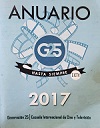 Anuario 2017 de la Escuela Internacional de Cine y Televisión de San Antonio de los Baños (EICTV)
Anuario 2017 de la Escuela Internacional de Cine y Televisión de San Antonio de los Baños (EICTV)
 Anuario 2017 de la Escuela Internacional de Cine y Televisión de San Antonio de los Baños (EICTV)
Anuario 2017 de la Escuela Internacional de Cine y Televisión de San Antonio de los Baños (EICTV)Marcius Freire
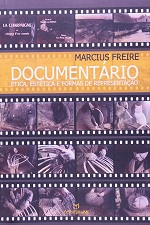 El autor busca presentar al lector los resultados de su investigación, los cuales están anclados en el incremento de la producción documental, tanto para pantallas de cine como de televisión. Las consideraciones de este volumen, por el objeto en el que se centran -y porque abarcan una variada gama de temas que subyacen a cualquier investigación más amplia sobre este objeto- pueden constituir una contribución a la continuación del debate teórico en torno al cine documental.
El autor busca presentar al lector los resultados de su investigación, los cuales están anclados en el incremento de la producción documental, tanto para pantallas de cine como de televisión. Las consideraciones de este volumen, por el objeto en el que se centran -y porque abarcan una variada gama de temas que subyacen a cualquier investigación más amplia sobre este objeto- pueden constituir una contribución a la continuación del debate teórico en torno al cine documental.
 El autor busca presentar al lector los resultados de su investigación, los cuales están anclados en el incremento de la producción documental, tanto para pantallas de cine como de televisión. Las consideraciones de este volumen, por el objeto en el que se centran -y porque abarcan una variada gama de temas que subyacen a cualquier investigación más amplia sobre este objeto- pueden constituir una contribución a la continuación del debate teórico en torno al cine documental.
El autor busca presentar al lector los resultados de su investigación, los cuales están anclados en el incremento de la producción documental, tanto para pantallas de cine como de televisión. Las consideraciones de este volumen, por el objeto en el que se centran -y porque abarcan una variada gama de temas que subyacen a cualquier investigación más amplia sobre este objeto- pueden constituir una contribución a la continuación del debate teórico en torno al cine documental.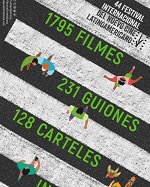 Catálogo General de la edición 44 del Festival Internacional del Nuevo Cine Latinoamericano de La Habana.
Catálogo General de la edición 44 del Festival Internacional del Nuevo Cine Latinoamericano de La Habana.Ana Rosas Mantecón
 El acceso extendido a internet a través de los teléfonos móviles ha convertido a los públicos un un hecho omnipresente del paisaje social. Y, sin embargo, desconocemos casi todo sobre ellos: su diversidad, transformaciones, percepciones, valoraciones y motivaciones, así como las implicaciones sociales y políticas de sus prácticas. Partiendo del hecho de que los públicos se crean y recrean permanentemente, este libro explora las diferentes maneras en las que se han construido históricamente y en la actualidad.
El acceso extendido a internet a través de los teléfonos móviles ha convertido a los públicos un un hecho omnipresente del paisaje social. Y, sin embargo, desconocemos casi todo sobre ellos: su diversidad, transformaciones, percepciones, valoraciones y motivaciones, así como las implicaciones sociales y políticas de sus prácticas. Partiendo del hecho de que los públicos se crean y recrean permanentemente, este libro explora las diferentes maneras en las que se han construido históricamente y en la actualidad.
 El acceso extendido a internet a través de los teléfonos móviles ha convertido a los públicos un un hecho omnipresente del paisaje social. Y, sin embargo, desconocemos casi todo sobre ellos: su diversidad, transformaciones, percepciones, valoraciones y motivaciones, así como las implicaciones sociales y políticas de sus prácticas. Partiendo del hecho de que los públicos se crean y recrean permanentemente, este libro explora las diferentes maneras en las que se han construido históricamente y en la actualidad.
El acceso extendido a internet a través de los teléfonos móviles ha convertido a los públicos un un hecho omnipresente del paisaje social. Y, sin embargo, desconocemos casi todo sobre ellos: su diversidad, transformaciones, percepciones, valoraciones y motivaciones, así como las implicaciones sociales y políticas de sus prácticas. Partiendo del hecho de que los públicos se crean y recrean permanentemente, este libro explora las diferentes maneras en las que se han construido históricamente y en la actualidad. André Gaudreault, Francois Jost


¿Qué diferencias hay entre un filme mudo y un filme sonoro? ¿Y entre un policíaco y una comedia? ¿Y entre una película de Jean Renoir y otra de Jean-Luc Godard? Muchas, evidentemente. Pero también un parecido esencial: todos ellos, a su manera intentan relatar, contar una historia.
Con el fin de analizar convenientemente la diversidad de filmes que componen la historia del cine, pues, hay que entender primero qué tienen en común todos los relatos cinematográficos. Y esto es lo que intenta hacer esta obra, mediante una exposición metódica de los conceptos clave de la narratología, principalmente los de narrador, tiempo y punto de vista.
Robert Stam, Robert Burgoyne, Sandy Flitterman-Lewis
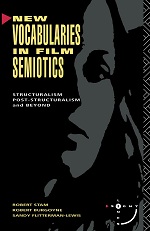 The boock provides a comprehensive lexicon of semiotic concepts. With sections on linguistics, narratology, psychoanalysis and intertextuality, it constructs an indispensable dictionary for film theory, defining over five hundred critical terms. The authors address key aspects of contemporary semiotics and cultural debate, while referring to the work of key figures such as Peirce, Saussure, Derrida, Barthes, Propp, Genette, Greimas, Kristeva, Lacan, Metz, Bellour, Heath, Mulvey, Johnston, Rose, Doane, Bakhtin and Baudrillard. The semiotic concepts are illustrated by examples drawn from the films of directors such as Welles, Dreyer, Brunel, Godard, Hitchcock, Varda, Akerman and Woody Allen. Although especially geared to the needs of film students, New Vocabularies in Film Semiotics should be useful for scholars in all areas of the arts, philosophy and literature.
The boock provides a comprehensive lexicon of semiotic concepts. With sections on linguistics, narratology, psychoanalysis and intertextuality, it constructs an indispensable dictionary for film theory, defining over five hundred critical terms. The authors address key aspects of contemporary semiotics and cultural debate, while referring to the work of key figures such as Peirce, Saussure, Derrida, Barthes, Propp, Genette, Greimas, Kristeva, Lacan, Metz, Bellour, Heath, Mulvey, Johnston, Rose, Doane, Bakhtin and Baudrillard. The semiotic concepts are illustrated by examples drawn from the films of directors such as Welles, Dreyer, Brunel, Godard, Hitchcock, Varda, Akerman and Woody Allen. Although especially geared to the needs of film students, New Vocabularies in Film Semiotics should be useful for scholars in all areas of the arts, philosophy and literature.
 The boock provides a comprehensive lexicon of semiotic concepts. With sections on linguistics, narratology, psychoanalysis and intertextuality, it constructs an indispensable dictionary for film theory, defining over five hundred critical terms. The authors address key aspects of contemporary semiotics and cultural debate, while referring to the work of key figures such as Peirce, Saussure, Derrida, Barthes, Propp, Genette, Greimas, Kristeva, Lacan, Metz, Bellour, Heath, Mulvey, Johnston, Rose, Doane, Bakhtin and Baudrillard. The semiotic concepts are illustrated by examples drawn from the films of directors such as Welles, Dreyer, Brunel, Godard, Hitchcock, Varda, Akerman and Woody Allen. Although especially geared to the needs of film students, New Vocabularies in Film Semiotics should be useful for scholars in all areas of the arts, philosophy and literature.
The boock provides a comprehensive lexicon of semiotic concepts. With sections on linguistics, narratology, psychoanalysis and intertextuality, it constructs an indispensable dictionary for film theory, defining over five hundred critical terms. The authors address key aspects of contemporary semiotics and cultural debate, while referring to the work of key figures such as Peirce, Saussure, Derrida, Barthes, Propp, Genette, Greimas, Kristeva, Lacan, Metz, Bellour, Heath, Mulvey, Johnston, Rose, Doane, Bakhtin and Baudrillard. The semiotic concepts are illustrated by examples drawn from the films of directors such as Welles, Dreyer, Brunel, Godard, Hitchcock, Varda, Akerman and Woody Allen. Although especially geared to the needs of film students, New Vocabularies in Film Semiotics should be useful for scholars in all areas of the arts, philosophy and literature.Greg M. Smith
 Synthesizing recent research on emotion in cognitive psychology and neurology, this study provides a more nuanced understanding of how film evokes emotion. Although the experience of emotion is central to movie-viewing, film studies have not focused on the emotions, relying instead on vague psychoanalytic concepts of desire. This volume describes a grounded approach to analyzing the emotional appeal of a wide variety of films (from Casablanca to Stranger than Paradise, from Renoir to Spielberg), showing how style and narration call upon the viewer's emotion system.
Synthesizing recent research on emotion in cognitive psychology and neurology, this study provides a more nuanced understanding of how film evokes emotion. Although the experience of emotion is central to movie-viewing, film studies have not focused on the emotions, relying instead on vague psychoanalytic concepts of desire. This volume describes a grounded approach to analyzing the emotional appeal of a wide variety of films (from Casablanca to Stranger than Paradise, from Renoir to Spielberg), showing how style and narration call upon the viewer's emotion system.
 Synthesizing recent research on emotion in cognitive psychology and neurology, this study provides a more nuanced understanding of how film evokes emotion. Although the experience of emotion is central to movie-viewing, film studies have not focused on the emotions, relying instead on vague psychoanalytic concepts of desire. This volume describes a grounded approach to analyzing the emotional appeal of a wide variety of films (from Casablanca to Stranger than Paradise, from Renoir to Spielberg), showing how style and narration call upon the viewer's emotion system.
Synthesizing recent research on emotion in cognitive psychology and neurology, this study provides a more nuanced understanding of how film evokes emotion. Although the experience of emotion is central to movie-viewing, film studies have not focused on the emotions, relying instead on vague psychoanalytic concepts of desire. This volume describes a grounded approach to analyzing the emotional appeal of a wide variety of films (from Casablanca to Stranger than Paradise, from Renoir to Spielberg), showing how style and narration call upon the viewer's emotion system.
